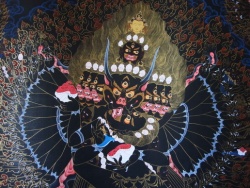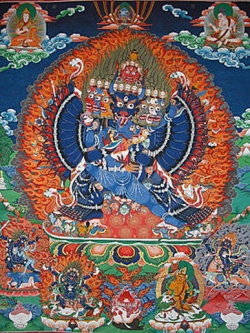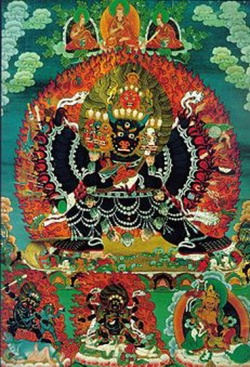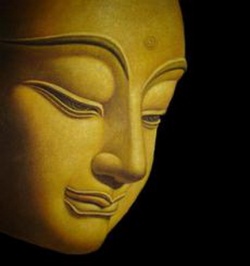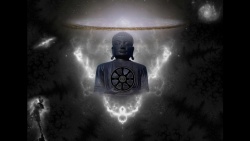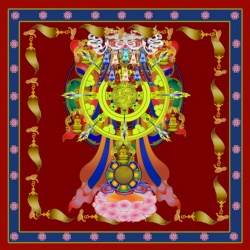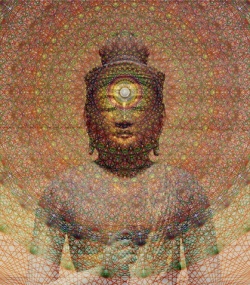A Teaching on Yamantaka
Bring your attention to the nature of your life, particularly the nature of samsaric life. Our life under the influence of delusions and karma is impermanent; it is suffering in nature. All people, possessions, and sense objects around us, all these causative phenomena, change within every second; they are constantly decaying. Under the control of causes and conditions, they do not last. These causative phenomena—including this life—can cease at any time. When death arrives, you have to leave everything. There is no choice but to separate from everything, including your cherished body.
Mindfulness of impermanence and death brings peace of mind. Realization of impermanence leads you towards liberation and enlightenment because it helps curtail obstacles—the disturbing emotions. Without mindfulness, meditation, and realization of impermanence and death, your attitude towards life is filled with disturbing emotions, particularly attachment. As a result, you are born repeatedly in samsara, especially in the lower realms of suffering. When you are mindful of impermanence and death, you want to practice Dharma and actualize the path to enlightenment.
In reality, everything—all actions, agents, and phenomena—is merely labeled by mind. How all phenomena exist is by being merely labeled by the mind in dependence upon a valid base. Even the base is that which is merely labeled by mind in dependence upon another base. It goes on and on like that. Starting from the I and going down to the sub-atomic particles of your body, everything is merely labeled in dependence upon a base. Nothing else exists except that which is merely labeled by the mind. What phenomena are is that which is merely labeled by mind. Everything exists in mere name. All phenomena are only nominally existent.
Therefore, the I, action, and all phenomena are totally empty. They are totally non-existent right there from their own side. As much as possible, try to practice mindfulness of emptiness and dependent arising—that everything exists in mere name in dependence upon its base, which also exists in mere name in dependence upon its base.
Living your life with the mindfulness that things do not exist from their own side is the ultimate solution to death. Common people find it unpleasant even to hear or think about death. The realization of emptiness is the ultimate means of overcoming death, of liberating yourself from the suffering of birth, aging, sickness, and death, and all the other sufferings that occur between birth and death as well. The realization of emptiness frees you from the oceans of suffering of each realm. In addition, it ceases even the subtle obscurations, making it possible for this mind-stream to become enlightened.
In reality, phenomena exist merely nominally, by being merely labeled by mind. But your past ignorance projects upon them the appearance of inherent existence. There is not just the appearance of action, object, I, form, sound, smell, and so forth, but something extra—inherent existence; something real appearing from there. Due to past ignorance, this projection occurs, and then your present ignorance apprehends it as true. This is happening in your own life, right now. Then your present ignorance, which apprehends all this as true, leaves the negative imprint on your mind-stream for phenomena to appear to you as inherently existent in the future. And again, you experience the appearance of an inherently existent I, inherently existent action, inherently existent form, sound, smell, taste, tangible object, inherently existent enlightenment, inherently existent hell, inherently existent liberation, inherently existent virtue and non-virtue, inherently existent happiness and suffering, inherently existent depression, inherently existent peace of mind, and so forth.
This has been happening in your life continuously, from beginningless samsaric rebirths. You have been completely trapped in hallucination. Besides being caught in the present hallucination, by following ignorance and not meditating on emptiness, sentient beings continuously create the cause for more hallucination in the future. It is like a fly inside a house. The windows and the doors may be open, but the fly does not go out. It does not go to where there’s an opening but flies around where there is no exit. Hitting its body against a closed window again and again, it ignores the freedom offered by all the open windows. It never even looks in their direction. Nobody is keeping the fly trapped in the house; the fly itself stays there. It never pays attention to the big space that is open all the time. It only looks where there is no space and goes around and around. Even though seeing the open space and flying there is so easy—there is no suffering or hardship involved—it does not do that. But the door is always open.
Your life is just like this example. The opportunity to attain liberation from samsara is always there. All phenomena, including I, action, and object, have been empty from beginningless time. It is not that phenomena have been empty at certain times and inherently existent at others. They have never been inherently existent. Therefore, the opportunity to realize emptiness has always existed and always will. By generating that realization, you will be able to eliminate the root of samsara, ignorance, the innate conception of inherent existence. By eliminating ignorance, you will cease everything that stems from it—all the other disturbing attitudes and emotions, all karma, the whole of samsara. You will attain complete cessation of suffering and its cause. Even though the opportunity to liberate yourself has always been there, so far you have not taken it.
Like the fly, you have not paid attention to or turned towards the door to liberation, the very nature of phenomena, the object of wisdom, emptiness. Continuously following ignorance, you have kept going towards suffering by believing the view of ignorance and thinking that the object of ignorance, which is false, is actually true. This has been your fundamental mistake.
In the view of your mind, every phenomenon, including the I, is one hundred percent existent from its own side, one hundred per-cent truly existent, one hundred percent not merely labeled by mind. Phenomena are one hundred percent real, one hundred percent there on the base, one hundred percent solid. When you look at the mountains, you think they are something real appearing from there. When you look at the road, it is a real road appearing from there. Your body is a real body appearing from there. Your emotions are real ones appearing from there. This is the view of ignorance.
Ignorance is the view of one part of your mind, but it is not the view of your entire mind. When your wisdom realizes emptiness, in the view of that wisdom mind, everything is empty. In the view of your wisdom seeing the ultimate nature of the person and phenomena, all these phenomena that ignorance apprehends as one hundred percent true are seen as false. In the view of the other part of your mind, wisdom, all the objects apprehended by ignorance—all these inherently existent things that appear real from there—are totally non-existent. This does not mean that all phenomena are non-existent. In the view of wisdom, all phenomena do exist, but they are totally empty of existing from their own side. In the case of the objects of ignorance, inherently existent phenomena, we can say they are completely non-existent. However, when speaking of nominally, or conventionally, existent phenomena, which do exist, we must include the qualifying term “from their own side” and say that they are totally empty of existing from their own side.
Rather than thinking that emptiness comes from outside, recognize that perceiving it depends on which mind you follow—you have different views. Your present view, the view of ignorance, is that everything you see—the lights, the carpet, your friends—is real from there, real from the side of their base. But this is not the view of all of your mind; it is just the view of one part of your mind. If you follow the wisdom mind, you will have a different view of life, phenomena, and yourself. The former view sees everything as inherently existent, the latter as empty. They are completely opposite perceptions. How you see the world, your life, and yourself is completely different in the two views. It becomes very interesting.
I, action, and object
I, action, object, and all other phenomena are simply that which has been merely labeled by the mind. Therefore, they are empty and do not exist from their own side. The I does not exist from its own side; neither do the action or the object acted upon. Similarly, all other phenomena do not exist from their own side, or under their own power, and are therefore totally empty.
The best meditation on emptiness is when there is no meditator, no action of meditating, and no object of meditation. The Guhyasamaja Root Tantra as well as sutra teachings say that if you can gradually approach this experience, you are meditating on emptiness correctly.
The body is not I. The mind is not I. The association of body and mind together is not I. The I exists nowhere on these aggregates. To express it another way, the aggregate of form is not I. The aggregate of feeling is not I. The aggregate of discrimination is not I. The aggregate of compositional factors is not I. The aggregate of consciousness is not I. Even the collection of all five aggregates is not I. No I exists anywhere on these aggregates. Be very clear about this. Firmly understand this.
It is very good if you can meditate on this and hold the experience steady for even an hour. The more you meditate on emptiness in session, the more you will be able to feel it during the breaks. Doing intensive meditation on emptiness and having intensive mindfulness of it enables the continuation of this understanding to remain even when you are working or engaged in other activities after your meditation session.
What is the I? It is that which is merely labeled by mind. Although that is sufficient, to make it clearer and be more precise, you may want to say that the I is that which is merely labeled by the mind in dependence upon the aggregates. Saying “in dependence upon the aggregates” counteracts the wrong idea that your mind’s labeling something is sufficient for it to exist. Your mind can label many things—such as a rabbit’s horn or a hairy turtle—that do not in fact exist. For something to exist, it needs a valid base in addition to the mind and label. The I, for example, exists by being merely labeled by the mind in dependence upon the aggregates, which are its base. The I cannot be labeled on just any base; it has to be valid. The aggregates are a valid base for the label I. The I is that which is merely imputed or designated by the mind in dependence upon a valid base. After the mind merely imputes the I, it believes that an I is really there. The I is just an idea or label that the mind makes up and believes.
Even the mind—the thing that makes up the label, that creates the idea—is not independent. It, too, does not exist at all from its own side, under its own power. What is the mind? Nothing other than that which is merely labeled by thought. Therefore, even the mind is empty. That which creates all these ideas is itself empty, not something concrete; it does not exist from its own side. This thing called “mind,” which exists and creates all these ideas and labels, is that which is merely labeled by thought. It exists by being merely labeled by thought in dependence upon a valid base.
After this analysis, it is clear that the I, which is merely imputed by the mind, and the mind itself, which is also merely imputed by thought, are totally empty from their own side. But they are not non-existent. They are like non-existent; it’s as if they do not exist. After this analysis, what you see and feel is not that they’re totally non-existent. They exist, but it is almost as if they don’t. What the I is, what the mind is, is unbelievably subtle. Even the mind that labels exists in an extremely subtle way.
In the same way, all phenomena exist so subtly that it is almost as if they were non-existent. If you analyze the base of the I—the aggregates—you have the same experience. From gross body down to its atoms, and from the mind down to the smallest moments of mind, everything exists by being merely labeled. You can mentally divide the continuity of consciousness into smaller and smaller time periods—year, month, week, day, hour, minute, second, split second, and so on. These mini-mind moments are the base in dependence upon which the mind is labeled. To ignorance, your hallucinating mind, all these appear inherently existent. They seem to exist from their own side, to be something concrete, something real from there, but in reality, in the view of wisdom, from the I down to the sub-atomic particles and from the mind down to the tiniest moments of consciousness, everything exists by being merely labeled. Having made this analysis, how do you feel your I and mind? It is not that they are non-existent, but it is like they are non-existent. What they are is extremely fine, extremely subtle.
From the I and the mind that labels I down to the sub-atomic particles and mini-moments in the continuity of mind, everything is totally empty of existing from its own side. They are totally non-existent from their own side. When you reach this conclusion, this experience, concentrate one-pointedly on emptiness.
Some lines in the Seven Points of Thought Transformation describe succinctly how to meditate on emptiness:
Having gained stability, receive the secret (teaching).
Consider all phenomena as a dream.
Examine the nature of unborn awareness.
The remedy itself is released in its own place.
Place (your meditation) on the nature of the foundation of all—
the essence (of the path). In the meditation break, be a creator of illusion.
Although few in words, these lines are very powerful to meditate on. Remembering just a few words helps you to not get caught in the words of emptiness but to reflect on its meaning. For example, “Be a creator of illusion” reminds you that you are the creator. With this awareness, practice mindfulness of things being like an illusion. By memorizing these lines, you can easily recall them when meditating. I do not know exactly what they mean, but I find them very effective, very powerful.
Similarly, The Thirty-seven Practices of a Bodhisattva contains some verses that give invaluable advice on how to use mindfulness of emptiness when you encounter problems.
Whatever appears is your own mind.
Your mind from the start was free from fabricated extremes.
Understanding this, do not take to mind
[[[Inherent]]] signs of subject and object—
This is the practice of bodhisattvas.
When you encounter attractive objects,
Though they seem beautiful,
Like a rainbow in summer, do not regard them as real
And give up attachment—
This is the practice of bodhisattvas.
All forms of suffering are like a child’s death in a dream.
Holding illusory appearances to be true makes you weary.
Therefore, when you meet with disagreeable circumstances,
See them as illusory—
This is the practice of bodhisattvas.
The last stanza speaks first of the mistake of looking at hallucinations as true. Doing so makes you suffer; it tortures your life; it is exhausting. Then Togme Zangpo gives the solution. When you meet unfavorable conditions, see them as hallucinations. That is, when things happen that you do not like, that you think are objectionable, practice as bodhisattvas do by seeing them as hallucinations. To see as a hallucination what is in fact a hallucination is a powerful technique. There are no truly existent problems.
In addition to seeing that no truly existent problems exist out there, you can transform the problem by transforming your concept of it. Change the concept that labels it as a problem and views it as a problem into a thought that gives a positive label to that situation and thus looks at the situation positively. For example, instead of labeling it as a problem, label it as an opportunity to practice patience.
What is an illusion?
Rinpoche: In English, does the word “illusion” only refer to a magician’s creation?
Student: Illusion can refer to a range of things, not only what is created by a magician. A hallucination is an illusion, a mirage is an illusion. So is a reflection in a mirror. A mistaken idea is also an illusion.
Rinpoche: What is a mirage?
Student: It’s an appearance of water where there is no water.
Rinpoche: So the appearance of the water is an illusion?
Student: Yes.
Rinpoche: Then the appearance of the water does not exist.
Student: The appearance of the water does exist. The illusion exists, but the water does not exist.
Rinpoche: That’s correct. The appearance of water exists, but the water does not exist. So the appearance of the water isn’t a hallucination.
Student: Correct.
Rinpoche: Tsa! You contradicted yourself! So the appearance of water isn’t a hallucination.
Student: The appearance of the water isn’t a hallucination because the appearance is there. The water isn’t there. It’s like when you look up and see a face in the clouds. That’s a hallucination and an illusion. You know it’s only clouds in the shape of a face. There’s no real face there.
Rinpoche: Are the pictures of our gurus and statues of the Buddha that we see hallucinations?
Student: There is a particular tribe in Africa that cannot recognize objects in photographs. If you show them a picture of another member of the tribe, they will not recognize him because the photo is flat and still, while their friend is three dimensional and moves. We see a person in the photo because we read meaning into the shapes we see there. In a sense, that’s an illusion because we make it up in our mind. There’s really just a flat surface there. It only has meaning to us because as a convention, we give it that meaning. We reconstruct meaning in our mind.
Rinpoche: Which one is a hallucination—what we see or what they see?
Student: Going back to the mirage, there’s an illusion there, but there’s no water there.
Rinpoche: Yes. So you’re saying the appearance of water isn’t an illusion, right?
Student: There’s a sense object that is correct. The mirage exists and it’s not an illusion.
Rinpoche: So a mirage isn’t a hallucination? Isn’t the appearance of an inherently existent I an illusion?
Student: Yes.
Rinpoche: In that case, all sentient beings are already enlightened because the appearance of inherent existence does not exist because it’s a hallucination.
Student: It exists. If it’s a hallucination it does not follow that it does not exist. It exists as an hallucination.
Rinpoche: It exists as a hallucination, but it’s not a hallucination?
Student: There’s a basis out there that does not exist. The inherently existent I does not exist. But the perception of the inherently existent I does exist.
Rinpoche: So the appearance of the inherently existent I isn’t a hallucination?
Student: It is a hallucination. It exists as a hallucination.
Rinpoche: Are you saying that the appearance of inherent existence is like an illusion? So it’s not an illusion?
Student: It is illusion, that’s why it exists.
Rinpoche: It’s an illusion?
Student: There’s no basis for the perception. It’s an illusion.
Rinpoche: If the inherently existent I is an illusion, is the appearance of an inherently existent I also an illusion? Are those two the same? Think about it.
Spaced out meditating on empty space
Sometimes it seems difficult to see the I as empty. You do the meditation taking death as the path to dharmakaya, and at the clear light, you have an appearance of space, like a very clear autumn sky at dawn. It is devoid of the three—the white, red, and dark appearances. It is like the sky before it’s completely light but after the dark has gone. Space is often given as an analogy for emptiness because space is already empty of form. So initially, thinking of space helps some people have an idea of emptiness. Space is ordinary emptiness—the emptiness of form and substantial phenomena—but it is not emptiness of inherent existence. You have to go beyond seeing space.
The emptiness of inherent existence is also non-objectifying; it is empty. That intense emptiness is non-dual with you, with no differentiation between subject and object. It is very strong emptiness, totally empty from its own side.
However, many people think they are meditating on emptiness but actually, they are meditating on space. They have not yet touched actual emptiness, shunyata, the pure nature. Instead, their experience is like gazing into space. They meditate on space and label it “emptiness.”
I have not seen what follows in the texts; it is just my idea how to meditate on emptiness during the dharmakaya meditation. Rather than spacing out meditating on empty space, it is more useful to identify the refuted object, the real I appearing from there, the I that appears not to be merely labeled by mind. You have this false view grasping onto the refuted object all the time. You have this hallucination every moment. You are born with it from beginningless rebirth. You have continuously lived your life with this false view, this hallucination. Up until now everything that appears to your senses has been the refuted object. So far, why you have not been liberated from samsara is because you have not realized emptiness, not realized that the refuted object is totally non-existent, totally empty. The reason you have not realized emptiness is because you have not identified the refuted object.
To realize emptiness you first have to recognize the refuted object. Since emptiness is a lack of something—inherent existence—to realize emptiness you first have to be able to identify what it is a lack of. You have to recognize the false I, the I that does not exist. In the four-point analysis to realize emptiness, the first point is to identify the refuted object. Without first recognizing the refuted object, the inherently existent I, the inherent existence projected onto the merely labeled I, how can you prove it does not exist? The I that exists is the merely labeled one, but something extra on top of it appears to you. That is inherent existence, the refuted object.
At present you apprehend the inherently existent I that is projected onto the merely labeled I as true. It’s like there’s I on the I. In the view of your hallucinating mind, ignorance, it looks like there’s I on the I, an inherently existent I appearing on the merely labeled I. Apprehending inherent existence and believing it to be true obstructs your mind from seeing the reality, or the truth, of the I, the emptiness of the I. Because you are unable to see the emptiness of the I, the real nature of the I, you cannot see the I, how the I exists. You cannot see that the I exists as a dependent arising, as merely labeled by mind. Because you are unable to realize the real nature of the I, you are unable to realize the conventional nature of the I, the dependently arising I itself.
Therefore, the whole problem is not realizing as false that which is false; not realizing that the way the inherently existent I and inherently existent phenomena appear is false, that the I and all other phenomena do not exist in the way they appear. You have to see that which is false as false. Liberation from samsara starts from here. When you practice mindfulness recognizing the refuted object on the I as false, there is no foundation for any of the delusions to arise, because your wisdom knows the appearance of a real I is false.
Ignorance, on the other hand, apprehends things in the exact opposite way. It apprehends them as true; that this is reality; that inherent existence is the nature of all phenomena. The ignorance apprehending, or grasping, inherent existence creates all delusions, all karma, and all the oceans of suffering in each realm of samsara. That wrong concept is responsible for the entire problem. The opposite of ignorance is the wisdom that looks at the false object as false, that recognizes the refuted object as the refuted object, that sees as a hallucination what is in fact a hallucination.
In this way, you are able to overcome the delusions. The correct view does not give the delusions freedom to arise, to take over your mind and your life, to harm yourself and others. When you can recognize that this is false, it will not be long before you will realize emptiness. It takes just a second to realize that inherently existent persons and phenomena are totally non-existent. Then you have the wisdom realizing emptiness. When you have that, you will have definite, unshakeable faith that you can attain liberation. The wisdom realizing emptiness directly ceases all defilements, karma, and delusions, so you do not have to experience them at all. It ceases the result, true suffering in samsara. By ceasing the subtle obscurations, it enables you to attain enlightenment.
Apprehending the I that appears not merely labeled by mind as true, as reality, creates samsara. Looking at it as false, recognizing it as the refuted object, seeing it as a hallucination—whichever name works better for you—cuts all suffering and its cause at its root, bringing liberation or enlightenment. A huge difference exists between these two thoughts, these two opposite ways of looking at the object. Which one you follow makes a huge difference to your life right this minute. It also makes a huge difference for the future; it is the difference between being in samsara and experiencing nirvana.
Even if you do not realize emptiness, it is very useful to practice mindfulness that the way all phenomena appear to you and the way your mind apprehends them is not true. What appears to you, what you apprehend, is false. It is the refuted object; it is a hallucination. Look at everything—the I, the six sense objects, the apprehending mind, and the apprehended objects—as false. Just looking at things in this way, which is opposite to the way ignorance apprehends objects, is very powerful, even if you do not actually realize emptiness. This is an unmistaken way to practice and will lead you to understand that phenomena are empty.
It is better to practice this mindfulness than to think you are meditating on emptiness when you are actually meditating on space. Even if you spend a long time concentrating on space, it does not affect samsara because it is not real meditation on emptiness. But using the correct words as taught by the Buddha and Lama Tsongkhapa benefits your mind, even though at present your understanding of them may be superficial. Just repeating the words, “All phenomena are not inherently existent. They do not existent by their own nature. They do not exist from their own side, nor are they truly existent,” puts good imprints in your mind-stream. You benefit from repeating and reflecting on these correct terms, even though you have no image of what emptiness is at present. Although you are not really meditating on emptiness, you are planting the seeds of realization in your mind by repeating the correct words and concepts of Lama Tsongkhapa’s unmistaken, pure teachings.
If you just concentrate on space that is empty of form, you are not meditating on emptiness. In fact, you are focusing on the opposite because you are still apprehending inherently existent space and thinking that it is true. You still have the ignorance holding it to be true. In addition, you do not even have the correct words describing emptiness from Lama Tsongkhapa’s teachings, so you cannot leave positive imprints on your mind. Pabongka Dechen Nyingpo explained this in his teachings.
Put effort into looking at things as hallucinations; not merely labeled; false; refuted objects; empty; like a dream; like reflections; like illusions. There are many analogies to choose from, and you can select the one that works best for you. When you reflect in this way, the understanding that they are empty, non-existent from their own side, comes into your heart. This is correct understanding and correct meditation. Even if you cannot experience strong, intensive emptiness, just seeing things as totally empty from their own side, meditating on their being false, hallucinations, refuted objects is very powerful. It becomes correct meditation on emptiness, free of the dangers of incorrect meditation. Whether you use hundreds of logical reasonings from the philosophical texts or not, this is the essential point.
If space that is empty of form appears to your mind while you are meditating on the dharmakaya, examine, “How does that space appear to me? Does space or clear light appear to me as merely labeled by mind or not merely labeled by mind?” If it appears not merely labeled by mind, that is exactly the refuted object; that is the hallucination; that is what does not exist at all. Continuously focus on it being the refuted object or a hallucination. Concentrate on that. At the same time, reflect on the meaning of hallucination—that it is non-existent. Then there is no choice but that the object of ignorance becomes non-existent for your mind.
In summary, you can meditate on emptiness in different ways. Sometimes meditate by focusing on the I, as I described before, and try to get an idea of the emptiness of the I. You may have the experience of everything dissolving. There is nothing there—no color or form—but it is still just ordinary emptiness. In the middle of this space, you may have the feeling of me; that there is an I in space meditating on dharmakaya. That I who is meditating in space is what has to be negated or destroyed. That is the target to hit with the atomic bomb of dependent arising. Identify that as the refuted object, false, hallucination, totally non-existent.
Sometimes you can meditate on emptiness by applying the same analysis to the eight visions as the elements absorb. There is no other way for the visions to appear except the false way, as existing from their own side. For example, the black near-attainment vision appears as inherently existent, that is, as something real from there, as existing there on the base. Then you meditate, “A real black near-attainment vision appearing from there does not exist there.”
If you are familiar with the refuted object and can recognize it easily, you do not need many words. Simply saying, “This is the refuted object” will facilitate your understanding that it is empty. If you can do this, you get into emptiness quickly. If you are not as familiar or cannot identify the refuted object properly, using logical reasoning is helpful. Whether you use many words and many logical reasons is up to you. It is your choice and depends on your familiarity with meditation on emptiness. See which way is most effective for you and do that.
After meditating on emptiness for a while, think that the wisdom seeing this emptiness experiences the greatest bliss non-dual with emptiness, and meditate on that experience a little bit. Then think, “This is my future, resultant holy mind, dharmakaya, the transcendental wisdom of non-dual bliss and emptiness of Yamantaka.” Make the determination, "This is me."
Mindfulness
The most important meditation is practicing mindfulness of emptiness as described before. You can spend a weekend, a week, or even a month just practicing mindfulness in sitting meditation and in break times. It is extremely powerful. Break time does not mean a break from meditation but a break from sitting. You should continue your mindfulness in the break. In the morning, practice guru yoga and at the beginning of each meditation session do strong preliminary practices. Then focus on the different methods of analysis in your sessions. You can recite the Heart Sutra each session or even do retreat on the Heart Sutra or on the Perfection of Wisdom. If you really try to do this, your view of yourself and the world will change. Due to that, your attitude towards life will be totally different. You will see the interesting movie of your own mind.
The vipassana people do very strict, intensive retreats and always practice mindfulness. It would be good if you could practice with this intensity and strong focus, but your object of mindfulness should be different. Theirs is just walking, breathing, and sensations in the body. I have not heard of common vipassana meditation related to emptiness, where you are aware of the false appearance and the false view. If you could meditate as intensively as they do but use the methods described here, you would definitely cut the root of samsara.
In our courses, we tend to have many teachings and less meditation, and people lack the time to digest or experience the Dharma. You need to continue to meditate after the course. On the other hand, if we had less information and more meditation, people would not get a broad view of Buddhadharma. They might have some experience, but their general knowledge would be limited. When time is short, people cannot get much of an idea about the path to enlightenment. Learning the Four Noble Truths is good, but it is also limited, and so the purpose of your life becomes limited. Hearing teachings on bodhicitta and the Mahayana path makes the goal of your life profound and vast, like the sky. This is the idea behind the Kopan courses. People get a broad view of the path, depending on how much of the lam-rim is covered. In addition, they get some philosophical teachings and do some meditation. Many different types of people come to the courses. Some need more information, some need more meditation.
